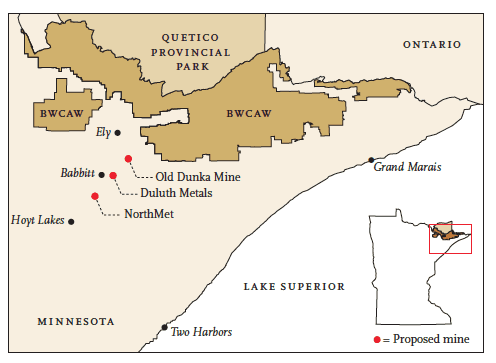By Charlie Mahler
 While industry leaders, environmental activists, and northeastern Minnesota stakeholders await publication of the revised Draft Environmental Impact Statement for PolyMet Mining’s proposed copper-nickel and precious metals mine, mining proponents and environmental activists continue to maneuver and skirmish ahead of what could be a new era in mining for the Quetico-Superior region.
While industry leaders, environmental activists, and northeastern Minnesota stakeholders await publication of the revised Draft Environmental Impact Statement for PolyMet Mining’s proposed copper-nickel and precious metals mine, mining proponents and environmental activists continue to maneuver and skirmish ahead of what could be a new era in mining for the Quetico-Superior region.
PolyMet and other firms are eager to develop a rich mineral resource locked underground near the southern limit of the Boundary Waters Canoe Area Wilderness, near the South Kawishiwi River. Environmental activists are concerned that mining ore from its sulfide-bearing rock could cause serious acid drainage issues for northeastern Minnesota’s lakes and rivers.
Ahead of the release of the new Draft EIS, expected later this year, PolyMet has tweaked its milling plans for the project. Originally, ore mined at their planned open pit mine near Babbitt, MN, was to be refined into finished copper at the operation’s mill in Hoyt Lakes. In a move which would save $127-million and reduce waste and emissions, PolyMet said, the company now intends to produce a high-grade copper concentrate at the mill. The company still intends to produce nickel-cobalt hydroxide and precious metal precipitate products as originally planned.
Duluth Metals, another company hoping to develop a rich deposit of copper-nickel resources just south of the BWCAW near Spruce Road, recently acquired Franconia Minerals Corporation which had itself probed for precious metals under Birch Lake on the South Kawishiwi River. Duluth Metals, is backed by Chilean mining giant Antofogasta.
Meanwhile, the Minnesota Chamber of Commerce has filed suit seeking to loosen water quality standards in areas where wild rice is grown, saying current regulations are too restrictive and not based on sound science. The suit claims the limit on sulfates to 10 milligrams per liter of water in lakes and rivers where wild rice is grown is overly restrictive to the mining industry. At press time, the Minnesota House is debating a measure that would increase the standard to 250 milligrams per liter.
Environmental advocates, on the other hand, say the limits, which have been in effect since 1973 but only recently enforced, are backed by a legitimate 60-year-old study which showed wild rice stands suffering at sulfates levels greater than 10 milligrams per liter. Wild rice stands become compromised when bacteria converts sulfates into hydrogen sulfide, which damages plants.
Environmentalists are also concerned about drainage of sulfates, acid, toxic metals, and other pollutants from the waste piles of the abandoned Dunka Mine, an iron mining operation near Birch Lake that exposed sulfide-bearing rock in the 1960s. The drainage of pollutants from the site coupled with the Minnesota Pollution Control Agency purportedly lax oversight of the situation has advocates concerned about the state’s ability to oversee the large copper-nickel mines
proposed for the area.
Mining skeptics have also called for the track record of one of PolyMet’s financial backers, Glencore International AG, to be scrutinized when it considers permitting of the company’s operation. According to group Water Legacy, the Swiss company founded by pardoned U.S. tax exile Marc Rich, has a troublesome history of environmental, economic, and worker-related problems that should be weighed by regulators in Minnesota.
Finally, five environmental groups are suing the State of Minnesota over a $4-million loan that Iron Range Resources approved for PolyMet Mining. The suit claims that the loan violates Minnesota environmental law which, the claimants say, prohibits state agencies like Iron Range Resources from investing in projects prior to environmental review and permitting.
Iron Range Resources approved the loan late last year to help PolyMet buy two pieces of land it intends to swap with the U.S. Forest Service for the Superior National Forest land where they intend to develop its mine.
Issues determining the future of copper-nickel mining in Minnesota will likely return to the top of the news late this year after the redone Draft EIS is released. The U.S. Army Corps of Engineers, the U.S. Forest Service, and the Minnesota Department of Natural Resources are preparing the document jointly. The rewrite of the comprehensive document comes after the federal Environmental Protection Agency deemed the initial Draft EIS “Environmentally Unsatisfactory-Inadequate.”


 While industry leaders, environmental activists, and northeastern Minnesota stakeholders await publication of the revised Draft Environmental Impact Statement for PolyMet Mining’s proposed copper-nickel and precious metals mine, mining proponents and environmental activists continue to maneuver and skirmish ahead of what could be a new era in mining for the Quetico-Superior region.
While industry leaders, environmental activists, and northeastern Minnesota stakeholders await publication of the revised Draft Environmental Impact Statement for PolyMet Mining’s proposed copper-nickel and precious metals mine, mining proponents and environmental activists continue to maneuver and skirmish ahead of what could be a new era in mining for the Quetico-Superior region.